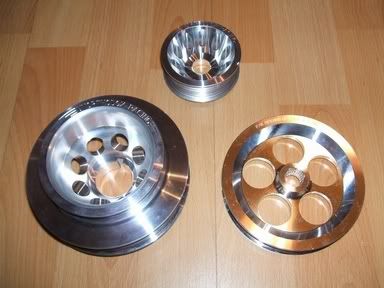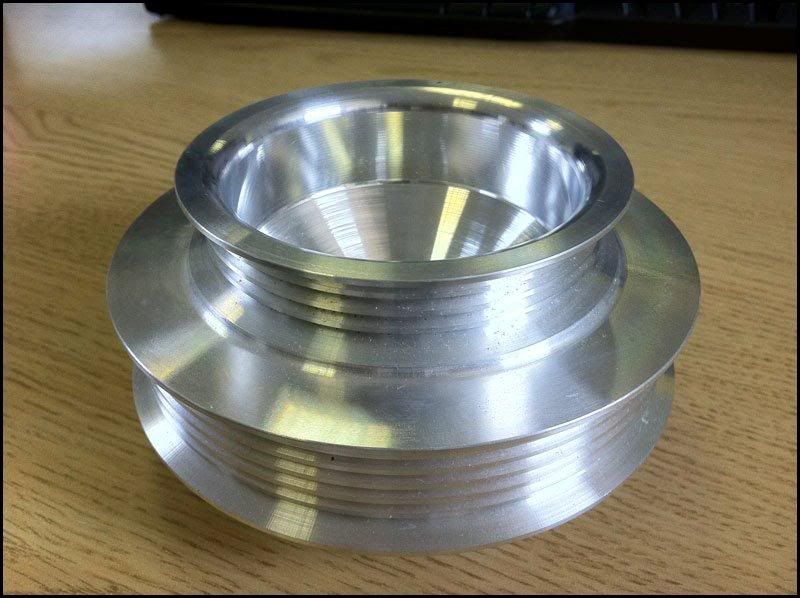Taffylude wrote:Lightweight Pulley Set
Lightweight pullies and underdrive pullies have got to be the most controversial modification available for the Prelude. Across nearly every forum I've been on, the opinion on these seems to be split 50:50.
The theory behind them is virtually the same as that of the lightweight flywheel, but applied to the opposite end of the crankshaft. The pullies are lighter (about 60% lighter), and therefore require less engine power to turn them, so this engine power is 'freed up'.
As well as being lighter, pullies are also available as 'underdrive'. This basically means that they have a smaller diameter crank pulley (around 20% smaller) and therefore will slow the speed at which the accessories such as aircon, alternator etc. run, therby freeing up slightly more HP and allowing the car to rev more freely (a similar effect to that of the lightened flywheel).
The big controversy centres around the fact that the stock Prelude crank pulley has a
rubber insert fitted in it.
The argument
against the aftermarket crank pulley is that the rubber insert is
required in order to dampen out any harmonics and vibrations from the crankshaft, which are the result of the internal combustion process.
The argument
for the aftermarket crank pulley points out that the rubber insert is purely an 'engine noise suppressor' similar to what the resonators function is on the air intake system, and the use of a solid metal pulley has no negative effects on the engine internals. They are also quick to point out that the Civic Type-R (which has a very similar engine & performance figures to the H22) comes with a soild metal crank pulley from the factory!
There is no real definative answer to this. There are people who claim that using one of these pullies caused premature wear to their crank bearings, but after looking into it, about 90% of claims like this seem to boil down to hearsay, and "it happened to a mate of a mate" etc. For the genuine cases where damage did occur, who's to say what caused it? A simple lack of lubrication on a bearing or over-revving of the engine could just have likely been to blame...
There are also many, many cases of people using these pullies for many thousands of miles and not having a single problem. Users of the pulley report that it free's up power right through the rev range, and is a great little mod.
I've ummed & arred about getting a set of these pullies ever since my stock crank pulley was damaged due to the pulley bolt not being tightened up properly during the last cambelt change

. If anyone remembers in
this thread, I had to get a second keyway cut into the pulley, 180 degrees out to the first

. So anyway, after speaking with a number of experienced engine experts, as well as my current engine builder, they've assured me that in their opinion these pullies will have no detrimental effect of the crankshaft, so I've decided to give them a try when the engine is re-built.
If I was going to use these I didn't want to stick any old Ebay rubbish on, so I chose to go for the
Unorthodox Racing underdrive pulley set.
They seem to be of very high quality, and are balanced from the factory.

Here's what Unorthodox Racing have to say on the rubber insert issue:
"Is my crank pulley a harmonic/torsional/vibration damper or a harmonic balancer?"
People are getting their crank pulleys confused with the harmonic dampers found on some V6 / V8 engines. "Harmonic Balancer" is a term used loosely in the automotive industry. Technically, this type of device does not exist. The "balancer" part comes from engines that are externally balanced and have a counterweight cast into the damper, hence the merging of the two terms. None of the applications we offer use a counterweight as part of the pulley, as these engines are all internally balanced.
The pulleys on most of the new import and smaller domestic engines have an elastomer (rubber ring) incorporated into the pulley that makes them look similar to a harmonic damper. The elastomer in the OEM pulley serves as an isolator, which is there to suppress natural vibration and noise from the engine itself, the A/C compressor, P/S pump, and alternator. This is what the manufacturers call NVH (Noise Vibration & Harshness) when referring to noticeable noise and vibration in the passenger compartment. It is important to note in these applications, the elastomer is inadequate in size and durability to act as an effective torsional damper. If you look at the pulleys on some imports there is no rubber to be found at all. We have samples of these, mostly from Acura/Honda, the Nissan Altima, 1.8L Eclipse, 2.3L Fords, Chrysler 2.2L's, and 1.8L VW's, to mention a few. This is not to say with our pulleys you will hear a ton of noise or feel more vibration from your engine compartment. Most owners who have installed our pulleys notice the engine actually feels smoother. This is result of replacing the heavy crank pulley with our crank pulley. NVH is variable and unique to every car. NVH will increase with the installation of an aftermarket intake and/or exhaust, for example. Think of OEM intake systems in newer cars, they use baffles and resonators in the intake to quiet all the intake noise. Aftermarket intakes eliminate these resonators and create dramatic increases in engine noise from the throttle opening and closing. So to most tuners, certain types of NVH can make the driving experience more enjoyable.
The purpose of a traditional harmonic damper is to protect against crank failure from torsional movement. This is not necessary in most modern engines because of the many advances in engine design and materials. Factors such as stroke length, displacement, inline, V configurations, piston dwell time, piston pin off-set, power output, etc., do determine when and how these harmonics and torsional movements occur.
Again, there is a lot of internet hearsay about crank pulleys. When engine problems occur, too often people are quick to blame the pulley first, rather than taking the time to look logically into why there was a problem. We hope that after reading this you will understand the crank pulleys better.
As said, I'm willing to give these a go, and I believe I've done enough research to at least try them out. If I hit problems down the road, then at least I went into it with my eyes open, and can report back on here


